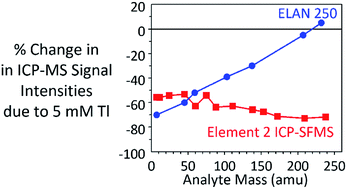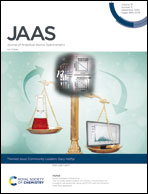Characterization of matrix effects using an inductively coupled plasma-sector field mass spectrometer†
Abstract
Matrix effects in ICP-MS are widely thought to be more severe for heavy matrix and light analyte elements due to space charge effects (ion repulsion following the formation of a positive beam downstream of the skimmer). It has been suggested that accelerating the ions downstream of the skimmer could possibly alleviate matrix effects by compensating for the kinetic energy differences between low and high mass ions. A sector field mass spectrometer (ICP-SFMS) which accelerates ions downstream of the skimmer using an extraction lens held at −2 kV, was used to comprehensively study matrix effects due to high concentrations of concomitant elements as a function of analyte mass, matrix mass, matrix element concentration, lens voltage, and nebulizer gas flow rate. The effects of matrix elements with a wide range of masses (Na, Cu, Y, In, Cs, Tb, Lu, and Tl) on analyte sensitivities with a wide mass range (7Li+, 11B+, 24Mg+, 45Sc+, 71Ga+, 75As+, 88Sr+, 111Cd+, 138Ba+, 153Eu+, 172Yb+, and 238U+) were characterized. The severity of matrix-induced changes in analyte sensitivities was similar for a single matrix element using the ICP-SFMS as those observed using an ICP-Quadrupole MS (ICP-QMS) which uses a single, low voltage positive ion lens. However, the ion beam current would be expected to be higher using the ICP-SFMS than using the ICP-QMS with a single positive ion lens due to the higher sensitivity provided by the ICP-SFMS (1 000 000 counts per s per ppb) versus the ICP-QMS used in this study (15 000 counts per s per ppb). Matrix effects using the ICP-SFMS for equimolar matrix element concentrations were more severe as the matrix element mass increased when a grounded guard electrode was used, while the analyte ion mass had little impact on the severity of matrix effects. When the guard electrode was ungrounded, the matrix effects were still not very dependent on analyte mass; the severity of the matrix effects was also not dependent on the matrix element mass. The lack of matrix severity dependence on analyte ion mass using ICP-SFMS, and recent reports using ICP-Quadrupole MS, is contrary to expectations if space charge effects were solely responsible for mass dependent matrix effects in ICP-MS.

- This article is part of the themed collection: Community Leaders: Gary Hieftje


 Please wait while we load your content...
Please wait while we load your content...